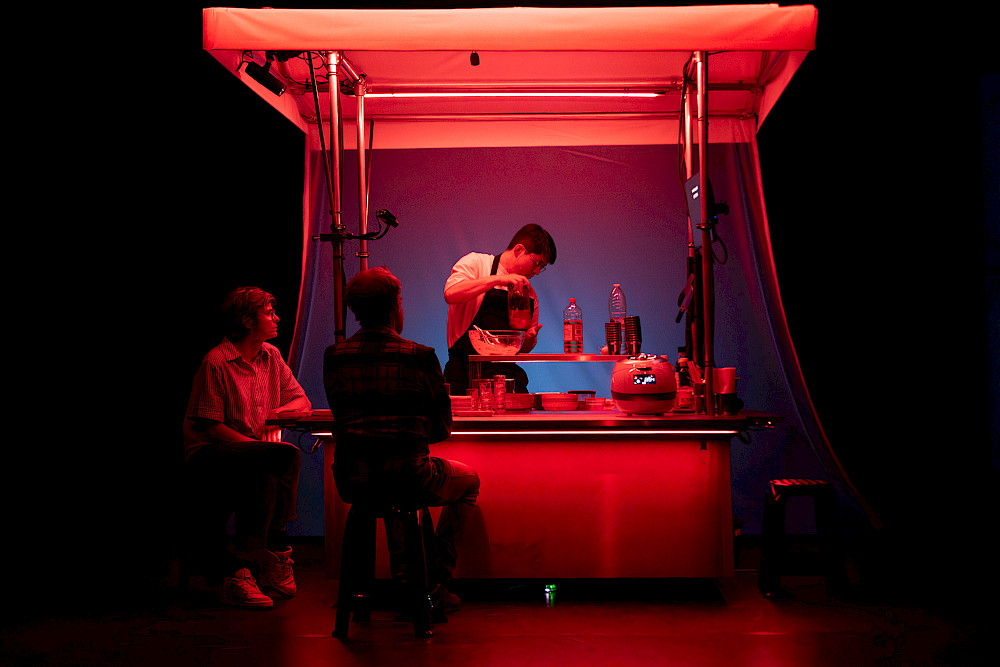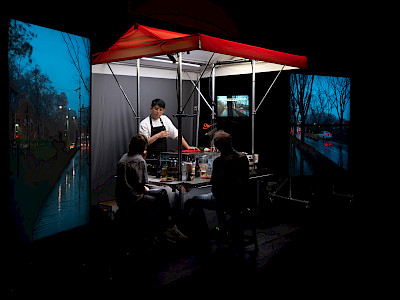21 — 25.05.2025
The surprising flavour of seaweed soup, the sharp sound of a knife slicing cucumber, the hiss and sizzle of mushrooms on a scorching fire. With Haribo Kimchi, we find ourselves in a pojangmacha, a typical late-night snack bar seen on the streets of South Korea. There, we meet three characters—a snail, a gummy bear, and an eel—who take us on a culinary journey, exploring food as a shelter for those estranged from their roots. In a series of intimate and absurd anecdotes, they recount the evolution of kimchi culture, the bitter pain of unadulterated racism, the shame of desperate attempts to blend in with the crowd, and the indescribable umami taste of home.
Following the success of his Hamartia Trilogy (2021), which delved into the far-reaching imperialism in East Asia, South Korean theatre maker and composer Jaha Koo returns to Kunstenfestivaldesarts. His patented hybrid style combines music, video, and robotic performers to craft a reflection on cultural assimilation with all its conflicts and paradoxes. In a gripping performance that plays with all the senses, he serves up personal stories marinated in sweet-and-sour melancholy.
"Koo is a jack-of-all-trades, appealing to all your senses. Haribo Kimchi is both a refined as well as a raw performance about life in a country that isn’t yours. Not only love but even melancholy are feelings that go through the stomach." - Floris Baeke, 2024, De Standaard
"A performance that inimitably mixes Korean cooking with personal stories and reflections on comfort food, identity and migration." - Pieter T’Jonck, 2024, pzazz
Interview with Jaha Koo
What is meant by ‘Haribo Kimchi’, the title of your newest creation?
‘Haribo Kimchi’ is an attempt to highlight identity, cultural collision, and hybridity through the juxtaposition of two seemingly incompatible food items. When I lived in Korea, Haribo wasn’t officially imported—you could only find it in a few specific stores through small-scale distributors. I didn’t even like gummy candy back then. It was only after moving to Europe that I began enjoying Haribo; it became a newly acquired taste and habit.
Kimchi, on the other hand, has been with me since the moment I was born. It carries with it the history of Korea, the time of fermentation, and a complex layering of sensory experience.
The line between fermentation and decay is incredibly thin, and it is in that fragile space where culture is either born or lost. When something I’ve acquired later in life—my personal taste, my adopted habits—collides with cultural inheritances that existed before I was even born, something new can emerge from that friction.
I see food as a kind of language. It is not just a means of survival but a powerful medium through which the structure of society, identity, memory, and emotion are expressed. Moving from a rural town to Seoul, and later from Korea to Europe, I experienced some of the deepest cultural clashes at the dining table. And in those moments, I kept arriving at different answers to the question: “Who am I?”
The title Haribo Kimchi is a metaphor for that contradiction, confusion, and the evershifting identity born from cultural tension and fluidity. I believe identity is not something fixed—it ferments, transforms, and comes into clearer focus over time. It is alive.
How does this performance relate to The Hamartia Trilogy, which you’ve been working on for seven years?
In some ways, Haribo Kimchi can be seen as a continuation of The Hamartia Trilogy, but at the same time, it marks a turning point—a transition into a new chapter of my artistic
journey. As in my previous works, I created the music and video myself, building a performance language that blends sound, image, and narrative as multidisciplinary way. But compared to the trilogy, there are significant shifts: the use of video has changed, the musicality has expanded, the scenography has become more conceptual, and the boundaries of performativity between reality and fiction are more blurred than ever.
Perhaps the biggest change is how I position myself within the work. In The Hamartia Trilogy, I often remained in the position of the observer—reflecting on historical,
social, and political issues from a somewhat analytical distance. But in Haribo Kimchi, the gaze turns inward. The piece centers around the unresolved, ambiguous, and perhaps endless experience of living as a foreigner. And I stand right at the center of that story.
While creating this work, I found myself constantly haunted by one question: “Where will I die?” Will I eventually return to Korea to die, or will I remain a perpetual traveler, dying somewhere far away, in a place that never truly felt like home? For those who’ve never had to ask themselves such a question—for those who never had to leave their homeland—Haribo Kimchi might come across as a light or casual story.
But when life becomes overwhelming, when the road ahead feels uncertain, we all try to comfort ourselves somehow. Sometimes we try to smile—not because we’re truly happy, but because it’s the only way to survive. Haribo Kimchi was, for me, a way to keep walking, by creating a moment of softness, of solace.
This work is a testimony told from somewhere in between—not quite Korean, not quite European. It is not a confession, but a sharing of existential trembling. It is the most honest story I can tell as someone who lives between identities, between places, between languages.
Can you explain why you felt the need to include humans in your stage set?
That shift was a very intentional choice. In many of my previous works, I appeared alone on stage with non-human performers like rice cookers or origami robots. But in Haribo Kimchi, I felt a strong need to bring humans onto the stage. It was a way of gently opening up the boundary between stage and audience, self and other, host and guest, foreigner and local. This openness was essential, because Haribo Kimchi is fundamentally about encounters—between cultures, histories, bodies, and the subtle ways in which something as simple as food can become a site of othering.
Haribo Kimchi is set in a pojangmacha. What role do these street food stalls play in South Korea?
There are several types. Some pojangmacha offer street food during the day, others serve simple dishes and drinks late at night. Since the early 2000s, many have disappeared— the government has driven them off the streets for reasons of hygiene, as well as issues concerning taxes and fees for occupying public space. The economic impact of Covid-19 has also wiped out many of them. I find these places incredible, unique. At night the pojangmacha can appear out of nowhere, serving people regardless of class, generation or gender, and then disappear like ghosts before dawn. They have no fixed address and do not exist in any database. They are ‘non-places’, as elusive as a liquid, and volatile, capable of wandering without a destination. It was while working
on Haribo Kimchi that I discovered the different forms they could take and the various states and spaces they embrace. They seemed to me to be the most appropriate framework for sharing the stories I wanted to tell.
You mentioned the “diaspora of kimchi culture”. What do you mean by this?
The “diaspora of kimchi culture” goes far beyond the simple idea of Korean food spreading globally. It refers to the way kimchi is reinterpreted, commodified, or adapted
depending on local contexts—gaining new meanings and identities as it travels. I believe that food doesn’t just move geographically; it carries with it memories, history, emotions, and politics.
While traveling to many different countries, I encountered numerous Korean diaspora communities and visited a wide range of Korean restaurants, each with its own story and reasons for leaving Korea. One memorable place was a Korean restaurant in Rome that opened in the 1980s. The food there carried the taste of the Korea from the ’80s and ’90s—a taste that is now difficult to find even in Korea today. It felt like history and time were flowing differently there.
There were also people who no longer spoke Korean or had much connection to Korean culture, yet still identified as Korean. In one case, I realized that despite generational shifts and the loss of language and culture, one thing that persisted was the act of making kimchi at home. Kimchi became a final, lingering marker of identity.
Through these experiences, I came to understand that there are countless types of kimchi in the world—and many I had never even encountered, despite having been born
and raised in Korea. Kimchi is not a static tradition, but rather a living cultural organism that holds within it layers of personal histories, regional transformations, and evolving
identities. In this way, kimchi culture reflects the complexity and diversity of diasporic life—and that’s what I wanted to explore and share through my work.
What kind of audience do you have in mind when you write?
I don’t write with a specific group or fixed identity in mind. Instead, I imagine those who carry what I call a sense of Jelliness. Jelly is soft and flexible. When pressure is applied, it bends, deforms—seemingly fragile—but then it bounces back, resilient and whole again. That texture, neither solid nor liquid, not easily broken but never rigid, fascinates me. This state—resisting hardness, embracing transformation—is what I call Jelliness, and it became the most important keyword in this work. The non-human performers in the piece—the snail, the Haribo jelly, the eel—are all, in a way, my alter egos. Each of them carries their own kind of Jelliness. They are fluid, shifting beings who can-
not be reduced to any fixed identity. While working on this piece, I imagined being in dialogue with such characters— and with audiences who might resonate with them. I think my audience might be people who never feel fully “inside” or “outside”—those who consciously live across boundaries, crossing from center to margin, from inside to out, constantly negotiating their belonging. In a broader sense, they may not be diasporic in the traditional sense, but they live in a diasporic state—I wanted to speak to them. To you, who trembles like jelly, and yet, still remains.
- Interview conducted by Vincent Théval in April 2024 for the Festival d’Automne à Paris, and was updated by Jaha Koo in March 2025.
Vincent Théval is a radio producer, and writes articles about culture for the press.
Haribo Kimchi is also included in the Discovery Pass. More info on this page
Presentation: Kunstenfestivaldesarts, Le Rideau
Concept, text, direction, music, sound and video: Jaha Koo | Performance: Gona, Haribo, Eel, Jaha Koo and two guests | Dramaturgy: Dries Douibi | Scenography, research collaboration and media operation: Eunkyung Jeong | Artistic advice: Pol Heyvaert | Technical coordination: Korneel Coessens | Technicians: Bart Huybrechts, Babette Poncelet, Jasse Vergauwe | Production coordination: Wim Clapdorp | English proofreading: Jason Wrubell | Snail animation: Vincent Lynen
Production: CAMPO | Coproduction: Kunstenfestivaldesarts, Le Rideau, Theater Utrecht, SPRING Performing Arts Festival, Festival d’Automne à Paris, Théâtre de la Bastille, Tangente St-Pölten, & Espoo Theatre, Kampnagel International Summer Festival, Sophiensaele, Meet You Festival, Bunker, National Theatre and Concert Hall Taipei, Divine Comedy International Theatre Festival, Perpodium
With the support of the Tax Shelter of the Belgian Federal Government via Cronos Invest and the Government of Flanders
Performances in Brussels with the support of the Korean Cultural Center of Brussels
The prototype of the eel was developed as part of Innovation:Lab’s funnel in coproduction with Theater Utrecht and creative technologists Adriaan Wormgoor and Willem Vooijs



